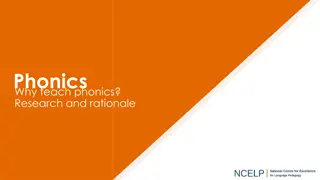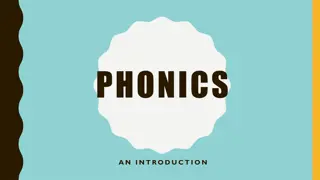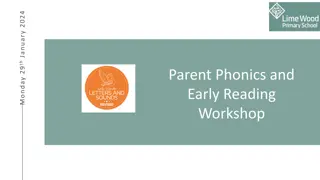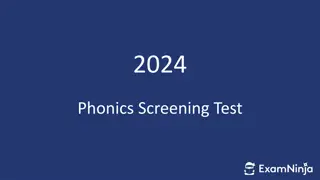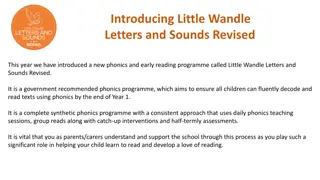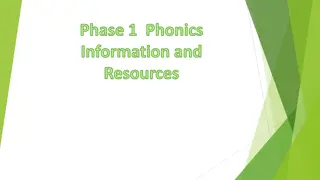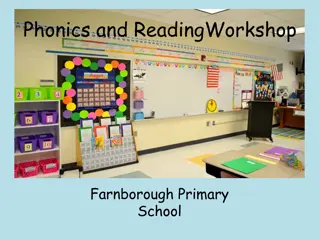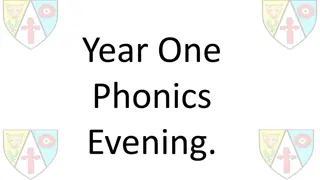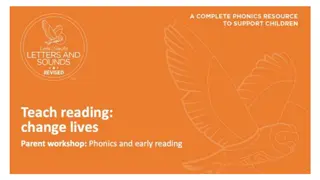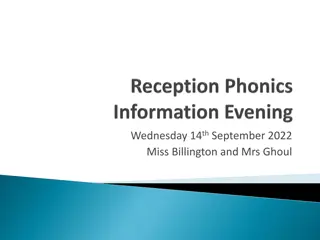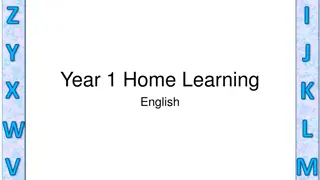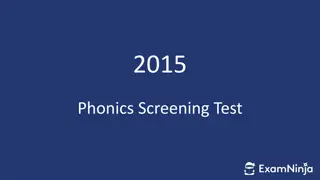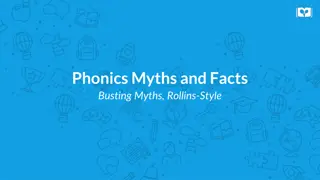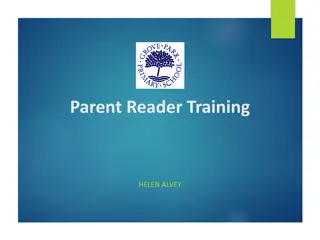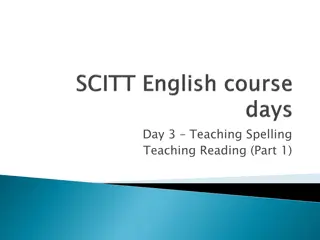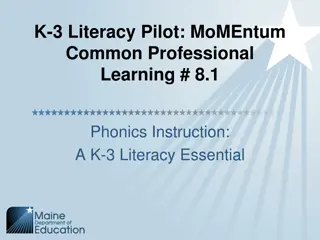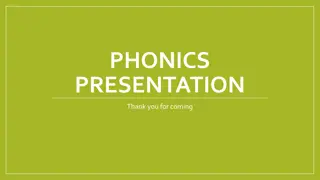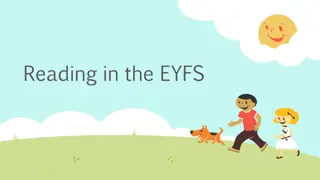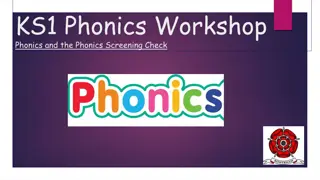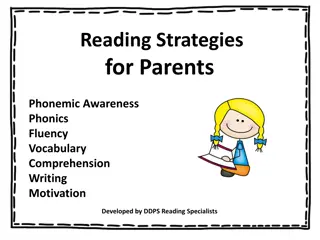Understanding Phonics: The Key to Reading Success
Phonics is a method of teaching the connection between sounds and letters to help children learn to read and spell. It involves recognizing phonemes, blending sounds to form words, and assessing proficiency through screenings. The phases of phonics progress from basic letter sounds to more complex digraphs and alternative pronunciations, ultimately building a solid foundation for literacy skills.
Download Presentation

Please find below an Image/Link to download the presentation.
The content on the website is provided AS IS for your information and personal use only. It may not be sold, licensed, or shared on other websites without obtaining consent from the author. Download presentation by click this link. If you encounter any issues during the download, it is possible that the publisher has removed the file from their server.
E N D
Presentation Transcript
What is phonics? Words are made up from units of sound called phonemes. Phonics teaches the relationship between letters and these sounds.
Year 1 Phonics Screening Every Year 1 child in the country will be taking the phonics screening. Children will be asked to say or sound out a word and blend the sounds e.g. b-oa-t boat The screening will contain a mixture of 40 words and non-words. Teachers will conduct the screening 1:1. To pass children have to successfully blend 32 words.
Screening check examples https://assets.publishing.service.gov.uk/government/uploads/system/uplo ads/attachment_data/file/532604/2016_Phonics_screening_check_pupils __materials_-_standard__STA167501e_.pdf Common errors Says the sounds correctly, but misses out a sound when blending it back together. Unsure of the digraphs / trigraphs. b / d confusion. Spotting split digraphs. Compound words (encourage children to split up the word). Consonant clusters.
Phase 2 Phonics is about pure sounds. Please do not add uh onto the end of sounds. s a t p i n m d g o c k ck e u r h b f ff l ll ss
Phase 3 Most sounds are made of two letters called digraphs. Some are made of 3 letters called trigraphs. j v w x y z zz qu ch sh th ng ai ee igh oa oo (book) oo (moon) ar or ur ow oi ear air ure er
Phase 3 Orally blend and segment a wider set of words Robot talk chip fizz sheep light pure hear
Phase 4 Children continue to apply knowledge from previous phases and extend using consonant clusters phase 3 digraph/ trigraph phase 3 word phase 4 word crown cow ow air chair stair
Phase 5 ay ou ie ea oy ir ue (glue) ue (queue) aw wh ph ew (grew) ew (new) oe au ey a-e e-e i-e o-e u-e (flute) u-e (cube) https://www.youtube.com/watch?v=CHZUE2e6BgI
Phase 5 Alternative pronunciations for sounds are taught. ai ay a_e
How many ways can you make the igh sound? igh ie i_e i y
How many ways can you make the ee sound? ea ey e_e e y
Games and activities to do at home
Websites and Apps - Education city. - Top marks. - Phonics play. - Oxford phonics check support (create your own word list) http://oxfordphonicschecksupport.co.uk/generate
Flashcards Do not have to be fancy or laminated! Could get the child to make them. Keep it short and frequent. Do a few at a time until they are confident with them. But come back to the same ones after a week or so, to make sure they have remembered them. Keep some that they know in the pile to help with their confidence.
Reward success Get a penny for their piggy bank for each word/10 words, they get one right. Have one minute of golden time for every 10 words they get correct. If they can get 20 words correct, they get to go for a swim or bike ride! Get a bookmark once they have learnt all the sounds or words within the phase they are currently working at. Within reason you can negotiate rewards this makes them more meaningful
Games If they say the sounds correctly, write or stick them to the template
When they have filled the rocket, or reached the top of the ladder, or written on each brick or balloon, they get a reward, or colour the picture. Keep it simple!
Car games You say the word, they segment it into sounds. You say the sounds, they blend them into a word. Make a sentence using the word stay You say the sound, they say the different combinations of letters ai a i or a y or a_e Which letters make the ai sound in play?
Ping pong game For the ping pong game you are changing one of the sounds in the word to make a new word. You say ping . They say pong .
Make a Rhyming String You say play They say day . You say way . They say stay . And continue until you run out of words. You could include nonsense words if you can t think of any real ones!
Shop game using one sound I went to the shops and I bought a knight. knight and a tie. knight, tie and a pie. knight, tie, pie and a kite.
House games Memory game Two of each digraph/word. Place upside down in a grid. Take it in turns to turn two over. It they match say the sound, keep them and have another go! If they don t match, turn them back over and the other person has a go. Name that teddy! Give your teddy silly nicknames and write name cards using the digraphs Trighfus, Goggleegoo, Roundious etc.
House games Snap words or digraphs. Say the word or digraph to win the cards. Tap a digraph/word. Space the digraphs out on a wall or door. You say a digraph/word, they tap it. How many can they do in 1 minuet? Dominoes Say the digraph/word when placing it down. Test the parent! Get them to test you.
Treasure hunt hide the digraphs/words around the house or garden. The children find them and read them. It they get it right, they can keep it. If they get it wrong, you tell them what it is and hide it again! Sound sorter Sort the words into different spellings. Example on phonics play website. Word sorter Sort words into real and nonsense words.
Hide and seek Hide the digraphs/words under cushions or stones. You say a digraph/word, they have to find it.
Get adventurous orienteering. Hide the digraphs/words around the local area or park. Make a map. The children have to find their way to the places and write the sounds on the map. It does not have to be to scale or look like an OS map!
Race the parent! Or sibling Place two sets of digraphs out on the floor or in the garden. Place a third set in a pile. Pick a digraph from the pile and race to find the matching digraph from the floor. Say the sound. Could keep score or get them to write the digraph under their name to reinforce how to spell it, then count up to see who the winner is.
Sentence substitution Think of a sentence using the appropriate digraph/words. Write the sentence in large lettering and cut up each word. Read the sentence and think of another word that could be inserted into the sentence. Check that it makes sense. You can see clowns at a circus. watch prices acrobats market Make up and write silly sentences, alien names and nonsense words using digraphs.
Resources Remember don t spend ages cutting and making. They don t have to be expensive bought games or cards. A piece of paper and a pencil is all you need. Can look at the phonics booklet we gave out. Could print off ready made resources. Phonics play teachers Printable resources. Some are free. Letters and Sounds - www.letters-and- sounds.com/
How you can support your child at home 3 5 times a week Supportive reading experiences: not a test (take it in turns; talk; games; time-limits etc) Get your child to apply their phonics Activating background knowledge: Tell them names of characters/places; identify sounds they re going to meet; make links with own experiences DO pay attention to your child s understanding DO communicate with us this is a partnership DON T struggle alone, we re here to support you


